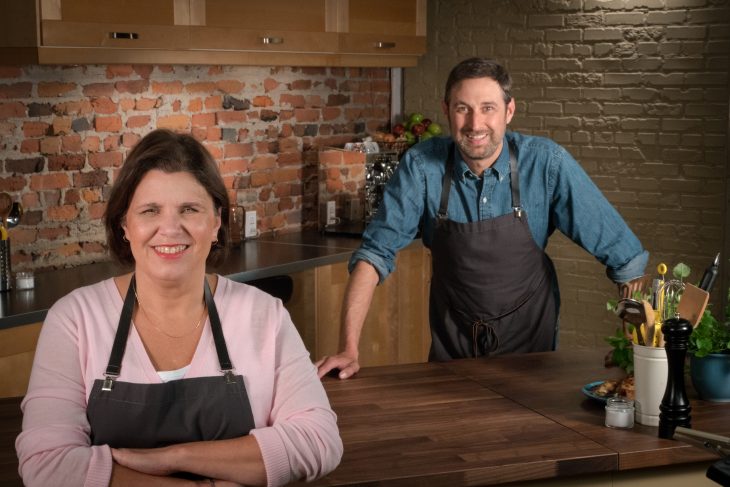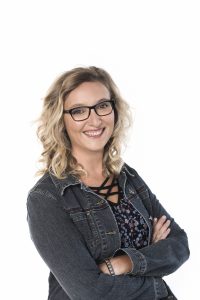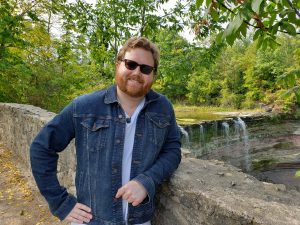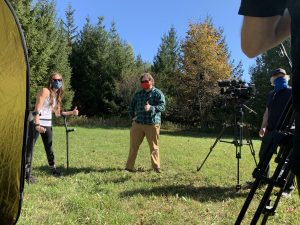
AMI broadcasters were already very good at finding creative solutions and adapting
By Ruby Pratka
WHEN THE COVID-19 pandemic hit, journalists had to radically change the way they worked almost overnight. Like thousands of reporters across Canada, Jessie Archambault had to get used to working from home and interviewing sources by videoconference. Once she resumed fieldwork, the Montreal-based reporter had to get used to wielding the two-metre-long microphone pole that allowed her to do physically distant interviews in person.
Fortunately, Archambault and her colleagues are used to finding creative solutions. Archambault is a reporter and producer at AMI, a nationwide cable TV and online media network that produces shows by, for and about the blind, Deaf and disabled community. They provide adapted TV for blind viewers through a process called Integrated Described Video, essentially laying the detailed verbal description of a good radio story over visual content; for Deaf viewers, subtitles are provided. Archambault herself has a visual impairment, as do many of her colleagues and sources; others are Deaf or have physical disabilities.
In pre-pandemic times, some contributors relied on adaptive technology in the studio. “Some of our talent could read a teleprompter, just with a larger font. One host was blind but could see light, so we created a frame of LED lights and hung that around the camera, so she knew where to look,” explains Michelle Dudas, an AMI senior producer in Toronto.
“It was daunting at first, but as we got into the rhythm, everyone was fantastic.” – Michelle Dudas, AMI

Jessie Archambault
Last spring, Dudas thought working from home might only be a short-term inconvenience; as reality set in, she ordered lights and tripods for her staff and talked them through the setup process over FaceTime. Reporters recorded content on their smartphones, which led to inevitable issues with connectivity and software compatibility. “It was daunting at first, but as we got into the rhythm, everyone was fantastic,” says Dudas.
“A few weeks after the pandemic started, we were back producing content,” recalled Archambault. “I was working from my kitchen table and half of my apartment was filled with equipment. Early in the pandemic, I filmed a series from home, and we arranged things so that the cameraman, who was also at home, could activate the camera with software… It was a bit stressful, because I had to deal with the technology – the camera, the wires and the batteries – on top of the actual piece. It was work, but it was a great accomplishment!”
Alex Smyth is a Toronto-based producer who has vision and hearing impairments. He’s a Bureau Reporter on AMI This Week, its newsmagazine show, and hosts documentary programming. “The pandemic has changed a lot for us, because our contributors have varying levels of visual, hearing and physical limitations and varying levels of access [to space and connectivity]. Working out how to shoot things and how to interview people was a challenge.”
Over the course of the pandemic, Archambault and Smyth have mainly worked from home, but have done fieldwork when possible. At AMI’s six bureaus across the country (Vancouver, Edmonton, Toronto, Ottawa and Halifax, along with a French-language hub in Montreal) protocols around fieldwork vary according to fluctuating regional restrictions. Véronique Vézina has worked from home as much as possible for the last year, but for her, some studio time was unavoidable.
“I have to memorize where everyone is if I want to go talk to them. The mask also reduces my field of vision, so it’s harder to move around. It’s complicated at first, but after a few days of filming, it’s like nothing’s changed. You adapt.” – Véronique Vézina

Alex Smyth
She’s the co-host of a French-language cooking show for visually impaired people called Pas de panique, on cuisine! (Don’t panic, we’re cooking!) Unless she and her co-host, Robert Penny, alias Bob le Chef (pictured atop the story), were in the studio kitchen, there was no show. For Vézina, who is both visually impaired and at high risk for Covid, this meant nerve-wracking monthly bus rides from Quebec City, where she lives, to Montreal, where the show is filmed. It also meant getting used to a new way of working.
“Bob and I were used to working side-by-side, and suddenly we had to keep a two-metre distance,” she remembers. “It’s harder to react to what he’s doing, because I’m too far away to see it.” She has her own green room on the set, and each person involved in the production has their assigned seat and workspace: “I have to memorize where everyone is if I want to go talk to them. The mask also reduces my field of vision, so it’s harder to move around. It’s complicated at first, but after a few days of filming, it’s like nothing’s changed. You adapt.”
Producers also had to find workarounds to provide visual context. “If you can’t go into the field to film, how do you illustrate a story? How do you make it more than just two talking heads on a screen?” says Smyth. He and his team dug deep into AMI’s existing archives, online archives of generic footage and footage provided by sources.
“Even after the pandemic, we’re going to keep that in our toolbox.” – Alex Smyth
When the situation allowed, they also filmed outdoors. In November 2020, Smyth and his team produced a documentary on the Japanese practice of forest bathing – walking in the woods and consciously connecting with nature. The story tapped into the pandemic-fueled resurgence in outdoor activities, gave the producers a chance to get outside (right), and, thanks to videoconferencing, featured an interview with a Japanese expert. “Instead of focusing on our immediate region and what’s accessible to us here, we can reach across the globe and explore subjects that we wo uldn’t have been able to before, because of technology,” says Smyth. “Even after the pandemic, we’re going to keep that in our toolbox.”
uldn’t have been able to before, because of technology,” says Smyth. “Even after the pandemic, we’re going to keep that in our toolbox.”
“I have to congratulate my team, because I think they adapted so well and pivoted so naturally, just like in any other workplace,” says Dudas, the senior producer. “There was a bit of trial and error, for sure, but we’ve…managed to rise to the occasion, and I’m so proud of the stories we’ve been telling.”
Smyth hopes that the experience of the past year will eventually make the field of journalism itself more accessible. He points out that a lot of journalists with physical and sensory disabilities are “locked out” of entry-level jobs in the industry due to driver’s licence requirements. “I understand why they have those requirements; you have to go where the story is,” he says.
“But with remote work and Zoom and Skype, hopefully you can get away from some of those criteria, get more creative with storytelling… and keep telling the stories.”
Photos courtesy AMI.


